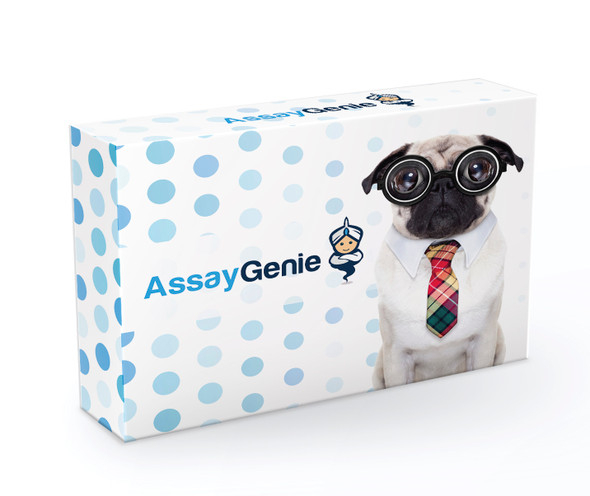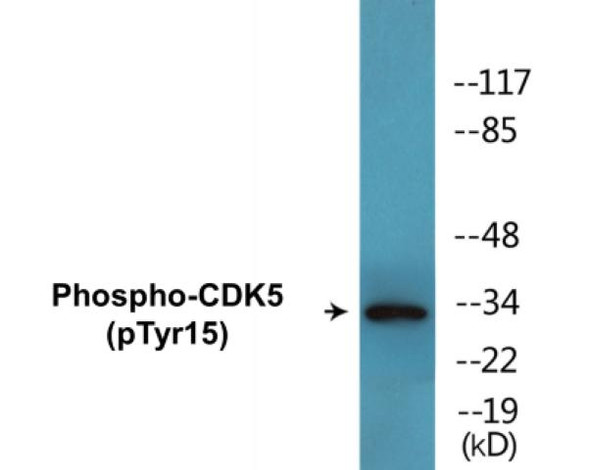Description
| Product Name: | CXCR4 (Phospho-Ser339) Colorimetric Cell-Based ELISA |
| Product Code: | CBCAB00036 |
| ELISA Type: | Cell-Based |
| Target: | CXCR4 (Phospho-Ser339) |
| Reactivity: | Human, Mouse, Rat |
| Dynamic Range: | > 5000 Cells |
| Detection Method: | Colorimetric 450 nm |
| Format: | 2 x 96-Well Microplates |
The CXCR4 (Phospho-Ser339) Colorimetric Cell-Based ELISA Kit is a convenient, lysate-free, high throughput and sensitive assay kit that can detect CXCR4 protein phosphorylation and expression profile in cells. The kit can be used for measuring the relative amounts of phosphorylated CXCR4 in cultured cells as well as screening for the effects that various treatments, inhibitors (ie. siRNA or chemicals), or activators have on CXCR4 phosphorylation.
Qualitative determination of CXCR4 (Phospho-Ser339) concentration is achieved by an indirect ELISA format. In essence, CXCR4 (Phospho-Ser339) is captured by CXCR4 (Phospho-Ser339)-specific primary antibodies while the HRP-conjugated secondary antibodies bind the Fc region of the primary antibody. Through this binding, the HRP enzyme conjugated to the secondary antibody can catalyze a colorimetric reaction upon substrate addition. Due to the qualitative nature of the Cell-Based ELISA, multiple normalization methods are needed:
| 1. | A monoclonal antibody specific for human GAPDH is included to serve as an internal positive control in normalizing the target absorbance values. |
| 2. | Following the colorimetric measurement of HRP activity via substrate addition, the Crystal Violet whole-cell staining method may be used to determine cell density. After staining, the results can be analysed by normalizing the absorbance values to cell amounts, by which the plating difference can be adjusted. |
| Database Information: | Gene ID: 7852, UniProt ID: P61073, OMIM: 162643/193670, Unigene: Hs.593413 |
| Gene Symbol: | CXCR4 |
| Sub Type: | Phospho |
| UniProt Protein Function: | CXCR4: Receptor for the C-X-C chemokine CXCL12/SDF-1 that transduces a signal by increasing intracellular calcium ion levels and enhancing MAPK1/MAPK3 activation. Acts as a receptor for extracellular ubiquitin; leading to enhanced intracellular calcium ions and reduced cellular cAMP levels. Involved in hematopoiesis and in cardiac ventricular septum formation. Also plays an essential role in vascularization of the gastrointestinal tract, probably by regulating vascular branching and/or remodeling processes in endothelial cells. Involved in cerebellar development. In the CNS, could mediate hippocampal-neuron survival. Acts as a coreceptor (CD4 being the primary receptor) for HIV-1 X4 isolates and as a primary receptor for some HIV-2 isolates. Promotes Env-mediated fusion of the virus. Monomer. Can form dimers. Interacts with CD164. Interacts with HIV-1 surface protein gp120 and Tat. Interacts with ARRB2; the interaction is dependent on the C-terminal phosphorylation of CXCR4 and allows activation of MAPK1 and MAPK3. Interacts with ARRC; the interaction is dependent on the C-terminal phosphorylation of CXCR4 and modulates calcium mobilization. Interacts (via the cytoplasmic C-terminal) with ITCH (via the WW domains I and II); the interaction, enhanced by CXCL12, ubiquitinates CXCR4 and leads to its degradation. Interacts with extracellular ubiquitin. Interacts with human cytomegalovirus/HHV- 5 protein UL78. Expressed in numerous tissues, such as peripheral blood leukocytes, spleen, thymus, spinal cord, heart, placenta, lung, liver, skeletal muscle, kidney, pancreas, cerebellum, cerebral cortex and medulla (in microglia as well as in astrocytes), brain microvascular, coronary artery and umbilical cord endothelial cells. Isoform 1 is predominant in all tissues tested. Belongs to the G-protein coupled receptor 1 family. 2 isoforms of the human protein are produced by alternative splicing. |
| UniProt Protein Details: | Protein type:Membrane protein, integral; Receptor, GPCR; GPCR, family 1; Membrane protein, multi-pass Chromosomal Location of Human Ortholog: 2q21 Cellular Component: cell surface; lysosome; leading edge; early endosome; cytoplasmic membrane-bound vesicle; integral to membrane; intercellular junction; growth cone; late endosome; cytoplasm; plasma membrane; cytoplasmic vesicle; external side of plasma membrane Molecular Function:G-protein coupled receptor activity; viral receptor activity; ubiquitin binding; protein binding; cytokine binding; ubiquitin protein ligase binding; myosin light chain binding; coreceptor activity; actin binding; C-X-C chemokine receptor activity Biological Process: entry of virus into host cell; regulation of chemotaxis; viral reproduction; activation of MAPK activity; apoptosis; neuron migration; motor axon guidance; regulation of cell migration; germ cell development; T cell proliferation; elevation of cytosolic calcium ion concentration; germ cell migration; dendritic cell chemotaxis; positive regulation of oligodendrocyte differentiation; inflammatory response; neutrophil activation; response to virus; calcium-mediated signaling; patterning of blood vessels; G-protein coupled receptor protein signaling pathway; ameboidal cell migration; myelin maintenance; response to hypoxia; entry into host cell; brain development Disease: Whim Syndrome |
| NCBI Summary: | This gene encodes a CXC chemokine receptor specific for stromal cell-derived factor-1. The protein has 7 transmembrane regions and is located on the cell surface. It acts with the CD4 protein to support HIV entry into cells and is also highly expressed in breast cancer cells. Mutations in this gene have been associated with WHIM (warts, hypogammaglobulinemia, infections, and myelokathexis) syndrome. Alternate transcriptional splice variants, encoding different isoforms, have been characterized. [provided by RefSeq, Jul 2008] |
| UniProt Code: | P61073 |
| NCBI GenInfo Identifier: | 46577576 |
| NCBI Gene ID: | 7852 |
| NCBI Accession: | P61073.1 |
| UniProt Secondary Accession: | P61073,O60835, P30991, P56438, Q53S69, Q9BXA0, Q9UKN2 B2R5N0, |
| UniProt Related Accession: | P61073 |
| Molecular Weight: | 40,221 Da |
| NCBI Full Name: | C-X-C chemokine receptor type 4 |
| NCBI Synonym Full Names: | chemokine (C-X-C motif) receptor 4 |
| NCBI Official Symbol: | CXCR4 |
| NCBI Official Synonym Symbols: | FB22; HM89; LAP3; LCR1; NPYR; WHIM; CD184; LAP-3; LESTR; NPY3R; NPYRL; HSY3RR; NPYY3R; D2S201E |
| NCBI Protein Information: | C-X-C chemokine receptor type 4; fusin; CD184 antigen; SDF-1 receptor; LPS-associated protein 3; neuropeptide Y receptor Y3; seven transmembrane helix receptor; stromal cell-derived factor 1 receptor; lipopolysaccharide-associated protein 3; seven-transmembrane-segment receptor, spleen; leukocyte-derived seven transmembrane domain receptor |
| UniProt Protein Name: | C-X-C chemokine receptor type 4 |
| UniProt Synonym Protein Names: | FB22; Fusin; HM89; LCR1; Leukocyte-derived seven transmembrane domain receptor; LESTR; Lipopolysaccharide-associated protein 3; LAP-3; LPS-associated protein 3; NPYRL; Stromal cell-derived factor 1 receptor; SDF-1 receptor; CD_antigen: CD184 |
| Protein Family: | C-X-C chemokine receptor |
| UniProt Gene Name: | CXCR4 |
| UniProt Entry Name: | CXCR4_HUMAN |
| Component | Quantity |
| 96-Well Cell Culture Clear-Bottom Microplate | 2 plates |
| 10X TBS | 24 mL |
| Quenching Buffer | 24 mL |
| Blocking Buffer | 50 mL |
| 15X Wash Buffer | 50 mL |
| Primary Antibody Diluent | 12 mL |
| 100x Anti-Phospho Target Antibody | 60 µL |
| 100x Anti-Target Antibody | 60 µL |
| Anti-GAPDH Antibody | 60 µL |
| HRP-Conjugated Anti-Rabbit IgG Antibody | 12 mL |
| HRP-Conjugated Anti-Mouse IgG Antibody | 12 mL |
| SDS Solution | 12 mL |
| Stop Solution | 24 mL |
| Ready-to-Use Substrate | 12 mL |
| Crystal Violet Solution | 12 mL |
| Adhesive Plate Seals | 2 seals |
The following materials and/or equipment are NOT provided in this kit but are necessary to successfully conduct the experiment:
- Microplate reader able to measure absorbance at 450 nm and/or 595 nm for Crystal Violet Cell Staining (Optional)
- Micropipettes with capability of measuring volumes ranging from 1 µL to 1 ml
- 37% formaldehyde (Sigma Cat# F-8775) or formaldehyde from other sources
- Squirt bottle, manifold dispenser, multichannel pipette reservoir or automated microplate washer
- Graph paper or computer software capable of generating or displaying logarithmic functions
- Absorbent papers or vacuum aspirator
- Test tubes or microfuge tubes capable of storing ≥1 ml
- Poly-L-Lysine (Sigma Cat# P4832 for suspension cells)
- Orbital shaker (optional)
- Deionized or sterile water
*Note: Protocols are specific to each batch/lot. For the correct instructions please follow the protocol included in your kit.
| Step | Procedure |
| 1. | Seed 200 µL of 20,000 adherent cells in culture medium in each well of a 96-well plate. The plates included in the kit are sterile and treated for cell culture. For suspension cells and loosely attached cells, coat the plates with 100 µL of 10 µg/ml Poly-L-Lysine (not included) to each well of a 96-well plate for 30 minutes at 37°C prior to adding cells. |
| 2. | Incubate the cells for overnight at 37°C, 5% CO2. |
| 3. | Treat the cells as desired. |
| 4. | Remove the cell culture medium and rinse with 200 µL of 1x TBS, twice. |
| 5. | Fix the cells by incubating with 100 µL of Fixing Solution for 20 minutes at room temperature. The 4% formaldehyde is used for adherent cells and 8% formaldehyde is used for suspension cells and loosely attached cells. |
| 6. | Remove the Fixing Solution and wash the plate 3 times with 200 µL 1x Wash Buffer for five minutes each time with gentle shaking on the orbital shaker. The plate can be stored at 4°C for a week. |
| 7. | Add 100 µL of Quenching Buffer and incubate for 20 minutes at room temperature. |
| 8. | Wash the plate 3 times with 1x Wash Buffer for 5 minutes each time. |
| 9. | Add 200 µL of Blocking Buffer and incubate for 1 hour at room temperature. |
| 10. | Wash 3 times with 200 µL of 1x Wash Buffer for 5 minutes each time. |
| 11. | Add 50 µL of 1x primary antibodies Anti-CXCR4 (Phospho-Ser339) Antibody, Anti-CXCR4 Antibody and/or Anti-GAPDH Antibody) to the corresponding wells, cover with Parafilm and incubate for 16 hours (overnight) at 4°C. If the target expression is known to be high, incubate for 2 hours at room temperature. |
| 12. | Wash 3 times with 200 µL of 1x Wash Buffer for 5 minutes each time. |
| 13. | Add 50 µL of 1x secondary antibodies (HRP-Conjugated AntiRabbit IgG Antibody or HRP-Conjugated Anti-Mouse IgG Antibody) to corresponding wells and incubate for 1.5 hours at room temperature. |
| 14. | Wash 3 times with 200 µL of 1x Wash Buffer for 5 minutes each time. |
| 15. | Add 50 µL of Ready-to-Use Substrate to each well and incubate for 30 minutes at room temperature in the dark. |
| 16. | Add 50 µL of Stop Solution to each well and read OD at 450 nm immediately using the microplate reader. |
(Additional Crystal Violet staining may be performed if desired – details of this may be found in the kit technical manual.)






